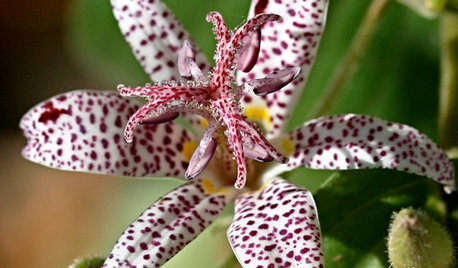Toads
14 years ago
Related Stories

SUMMER GARDENING10 Perennials to Extend Your Garden's Summer Color
Revive summer-weary gardens with outstanding late bloomers such as toad lily, Russian sage, blanket flower and more
Full Story
TASTEMAKERSA Designer Edits — and Adds — for Dramatic Effect
Interior designer Nancy Braithwaite’s new book shows how it’s possible to edit rooms of all styles to create their best look
Full Story
FALL GARDENING20 Favorite Flowers for the Fall Landscape
Vivid blooms and striking shapes make these annuals and perennials a delight in autumn gardens
Full Story
OUTDOOR ACCESSORIESGuardians of the Gate
Dog statues have long been used to adorn a home’s exterior, and man’s best friend usually has a message, too
Full Story
GROUND COVERSGive Your Lawn a Taste of the Wild
Consider the joys of an irregularly trimmed meadow lawn: It’s ecofriendly, visually interesting and still good for romping
Full Story
GARDENING GUIDESHow to Design a Garden That Lasts
Climates are changing. Wildlife is evolving. Can your garden keep up?
Full Story
HOUZZ TOURSMy Houzz: Cozy Country Meets Bohemian Artistic in Australia
Healthy helpings of salvage and rustic art give a pastureland home free-spirited style
Full Story
LANDSCAPE DESIGN7 Low-Maintenance Lawn Alternatives
Turf isn't the only ground cover in town. Get a lush no-grass lawn with clover, moss and other easy-care plants
Full Story
GARDENING GUIDESA Mom, a Garden and a Gift for the Neighbors
Gardening can be therapeutic in unexpected ways. See how one gardener found peace and purpose in a patch of Florida soil
Full Story
GARDENING GUIDES10 Solutions for Soggy Soil
If a too-wet garden is raining on your parade, try these water-loving plants and other ideas for handling all of that H2O
Full Story
Sponsored



mjandkids
quailhunter
Related Discussions
My chicken ate a toad!
Q
diatomaceous earth and toads?
Q
A Toad! A Toad!
Q
Toad care & toad love
Q
Okiedawn OK Zone 7
mulberryknob
Okiedawn OK Zone 7
lisatayOriginal Author
mulberryknob
river22
Okiedawn OK Zone 7
soonergrandmom
mulberryknob
Okiedawn OK Zone 7
Macmex
lisatayOriginal Author
Okiedawn OK Zone 7
angelmomma10_gmail_com